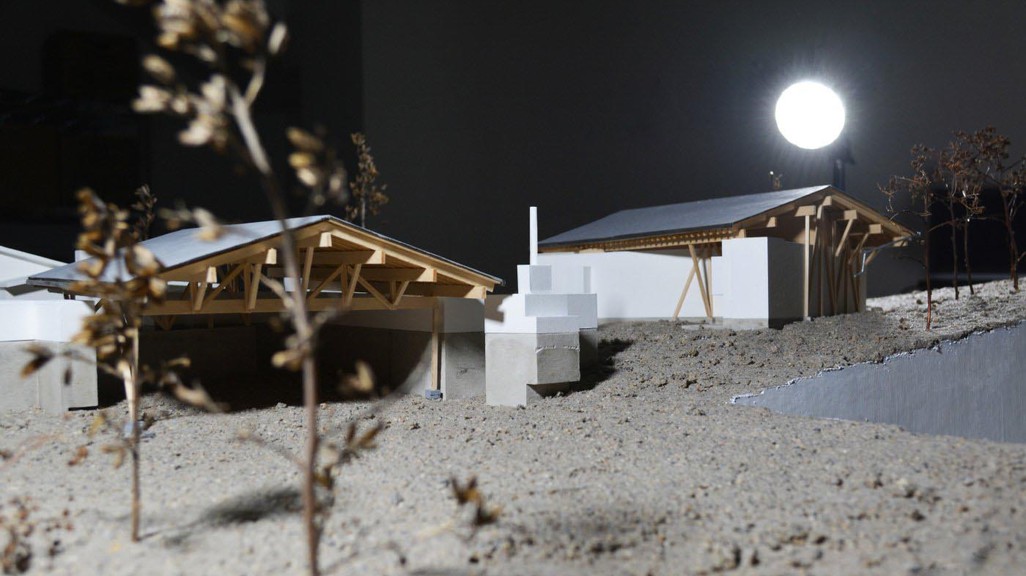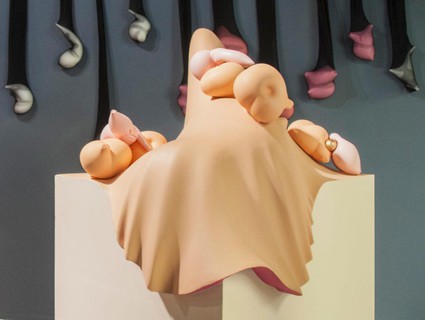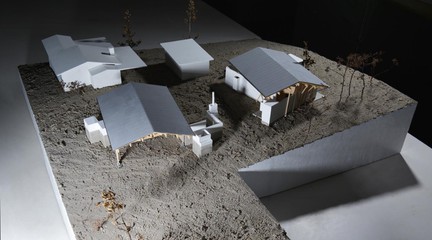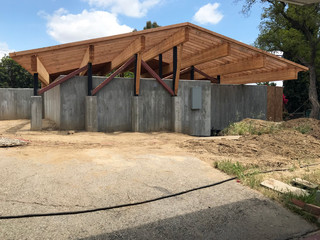
Building Practice in Parts: Alumni Benjamin Freyinger and Andrew Holder of The LADG
Feb 19, 2020
On September 3, 2019, Ella Arne and Eliza Williamson, students at Syracuse University, interviewed faculty member Benjamin Freyinger and Andrew Holder of the Los Angeles-based The LADG. Both are alumni of UCLA Architecture and Urban Design's M.Arch. program.
Thank you for joining us. Our first question is a very simple one; how and when did your practice start?
Andrew: We started our practice when we were still students. Ben and I were in graduate school at UCLA from 2002 to 2005, and we began working on our first project together at the end of 2004. If you look at the older projects in our portfolio, you’ll see stores for a ski boot retailer called Surefoot. Surefoot in Vail, Colorado was our first project. I don’t think we intended to form a durable corporate entity at that time, and it wasn’t our intention to be a practice forever. The Surefoot store was our first opportunity and was followed very quickly by a residential remodel in downtown Los Angeles and a loft building across the street from SCI-Arc. But to the original question, “How did it start?”… we were raised on a myth of how architecture firms start. You sit down and write to clarify your position in the world. After that is absolutely clear to yourself and others, you begin to work. Our experience was almost exactly the opposite… the work came first.
What is the identity of your practice, and how has it changed over the years?
Andrew: We started our practice during boom years for construction in Los Angeles. It was a good time to be an architect. For the first four years, we were totally consumed with work and executing projects commissioned by various clients. During the financial crisis of 2008 it became clear to us that architecture purely as a service for the market was not enough for us. We decided that we needed another layer of activity or set of incentives to impel what we were doing, because we felt as though the financial crash had removed many market-based incentives. We weren’t making money anymore. The thinness of incentives that we had thought would stick around forever was revealed.
We needed new reasons to get out of bed in the morning, which lead us back to the idea that we needed an operating theory of what architecture wants to be in the world. We asked ourselves why we do this on a very personal level, but also how architecture can engage a broader audience. It was in 2009, 2010, and 2011 when we first started thinking through architecture’s relation to audience. In those years, you see the emergence of animal figures and biomorphic forms in our work. These things were essentially the most direct answer that we could imagine to the question of how architecture interfaces with a mass audience. Our answer to that was architecture sheds its status as an object, and it becomes a subject. I know how to participate in a crowd if I’m a living thing. We were doing everything we could think to do to turn architecture into a subject that could participate like other people. We reached a limit with 48 Characters, an installation at the University of Michigan where we were creating plaster versions of balloon animals. We started to realize that if architecture as a subject needs formal complication, then we have to come up with different ideas about how to make habitable space. It’s a very simple initiating problem. And that question essentially initiated a string of investigations up to the present day where we are thinking about assemblies of objects that produce rooms.
We were talking about how your work resonates differently with different audiences. How do you maintain the identity of your practice considering both of you are in different locations.
Andrew: So, bear in mind we started as students, which means that didn’t yet have formalized understandings of our roles. What we had was a desire to work together. It was when we started living on different coasts that we had conversations about who does what. It was that moment of specialization that also required us to have conversations about the operating theory of the practice. All of a sudden, in order to be efficient in schematic design, we needed to constantly be referring back to ideas we had about how to make space and how to use assemblies of objects loosely fit together to produce things like rooms and interior order. Those were as much theories of architecture and how it should work as they were a series of conversations regarding how to distribute labor between the two coasts, and how to clarify what Andrew does and what Ben does.
Ben: I agree. To be blunt about it, having two people with either similar ideas or productively conflicting ideas in the same room is not always productive. There’s the personal growth that you need to go through in order to expand in your career and move forward and learn new things that tends to get stunted when there is someone else in the room. Independently, we’ve discovered that the practice can grow and that there is a need for specialization. But no matter how specialized we each become in our roles, we still wear a lot of the same hats. We still do a lot of the same things.
Andrew: Here is an example of how, for instance, something we produce has multiple lives, and becomes useful for the office. When I wrote “Notes on More,” the Log piece about density, I was interested in an academic audience. But I was also writing it as a letter to our office. It was how I was structuring thoughts about design, and was asking, “Can this help give us a common understanding of how to sit down to work?” We’re always growing and shrinking, so it means anywhere from two to six people are participating in schematic design. Everyone has to be extraordinarily coordinated in their work output. The essays help hold that together.
Can you talk more about the way in which the preference for using everyday objects informs your aesthetic sensibility? Also, how does this approach impact constructability and construction?
Andrew: Interesting. We haven’t used the word sensibility a lot in our conversations with one another. But maybe we should more often, because we have definite ideas about where we want to end up in terms of how things look. We want a kind of casualness, as though materials could come together in a variety of orientations and we would have simply picked one of those possibilities. We want a sense that our material palette is not elevated and expensive, but is common to the point of being retrievable from a junkyard if funds are limited. We also want for the fits between things to produce an occasion for design. If things fit together too perfectly, design is discouraged. One way that we create opportunities for design is by subjecting our work to physics by frequently positioning things with respect to one another so that all of the energy and intensity is in an interface or point of contact.
Ben: We are using materials that are readily available and, in some cases, kind of ugly. And yes, it’s in the interface between the materials and how they respond to one another or how they coexist… it’s where the invention is. The reality is that we have contractors that are looking at what we are producing. What they see is complicated or complex. We can break it down very logically, piece by piece, and explain why it isn’t. But the reception of it is often “Oh, this is unusual… this is too complex to build.”
Andrew: I also want to say that the casualness and looseness is not just for its own sake. Actually, let me go back. I’m totally fine if it’s casualness for its own sake. I have no need to justify it further, but maybe we have an additional possibility. One thing that starts to happen as things are loosely arrayed against one another is the production of crenelated edges, which makes it difficult to assign things to the inside or outside. Elements often fall outside of the proper territory of the house or building. This means more engagement in the surrounding context. If you can’t figure out where the envelope is, you’re always questioning what’s around you. For us, that’s good politics. We want to self-consciously style ourselves as part of architecture’s progressive crowd, but we don’t see that as being related to exclusion on the basis of privilege—educational, financial, or otherwise. We’re trying to resort to things that have a democratic availability and low barriers to intellectual engagement.
Given this attitude towards being democratic and inclusive, what kinds of projects do you hope to work on in the future?
Andrew: In the very immediate future, we’re really interested in the suburbs and we’re really interested in the single-family home, which may seem a weird answer to your question. We’re trying to think of ways in which the form of the house can open up and start to create shared regions with neighbors. So, imagine many House in Los Angeles I’s next to one another. We’d have to imagine a different way of describing what constitutes yard or private ownership.
Ben: We’re looking at the fringe areas of Los Angeles, specifically hillside areas, which encourage invention with regard to what Andrew was saying about the concept of yard or the concept of private ownership. We want to challenge and reconsider these things.
Andrew: If you look at the larger context for House in Los Angeles I, you’ll see that it’s part of a series of suburbs that stretch between downtown Los Angeles and Pasadena. They’re all super irregular, hillside lots. House in Los Angeles I looks kind of flat, but it’s at the edge of a pretty steep hillside. What that means is that buildable area is tightly circumscribed. You can only put houses in certain spots, which leaves huge portions of the hillside unbuilt but also given up for shared uses. We want to be deliberate about how built form can preserve collective spaces that have already emerged, and start to encourage the emergence of new collective spaces.
What’s been the most fulfilling moment in your professional careers thus far?
Andrew: I had a very fulfilling experience on my last site walk at House in Los Angeles I. It’s been a while since I’ve been out there. When I went out, it was just after all of the rain in Los Angeles, but before the landscaping went in, so it was super muddy. My foot got stuck in one of the courtyards. There I was stuck in an idea we’d only been kicking around on paper.
Ben: I’m going to play a similar card, but I’ll zoom out a bit. For me, it’s the physical evidence of the work. I can relate this back to Andrew’s comment about how we choose to lead our lives in the office. If there’s physical evidence of that work in the world, that is also the litmus test of our success in trying to bring a desire to operate, practice, and live a certain way into the market productively and reconcile those two things. I can look at it, I can touch it, and I can see it. That never gets old.
This post is an excerpt. Read the full article on archpaper.com.
Related Faculty |
Benjamin Freyinger |



- 48 Characters, The LADG, 2013.
- House in Los Angeles I (Model Photo)
- House in Los Angeles I under Construction.